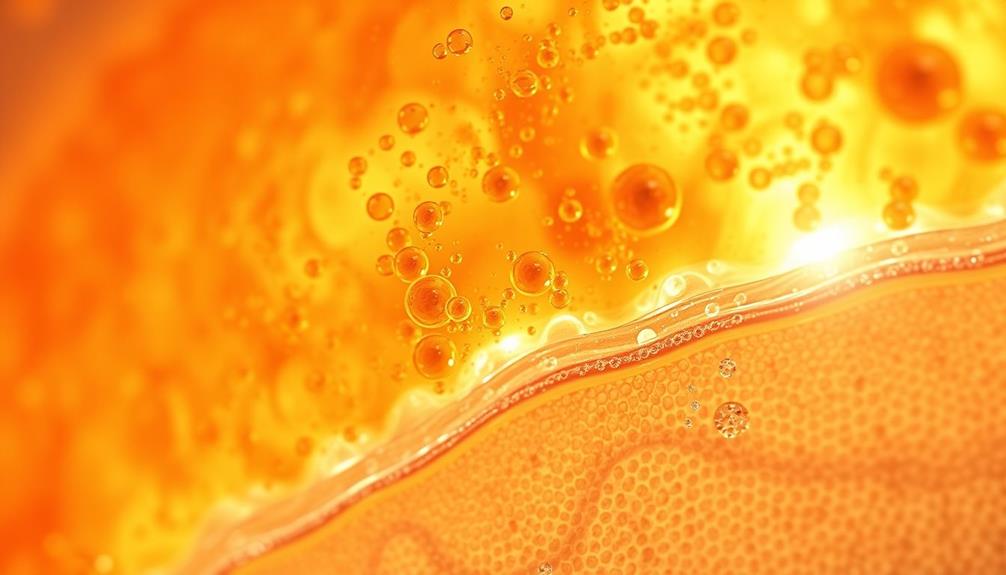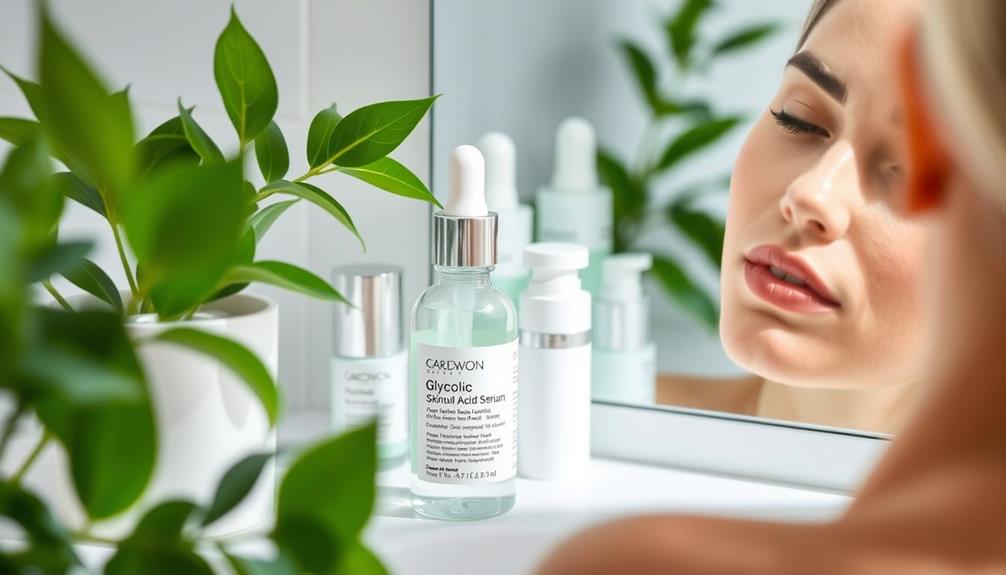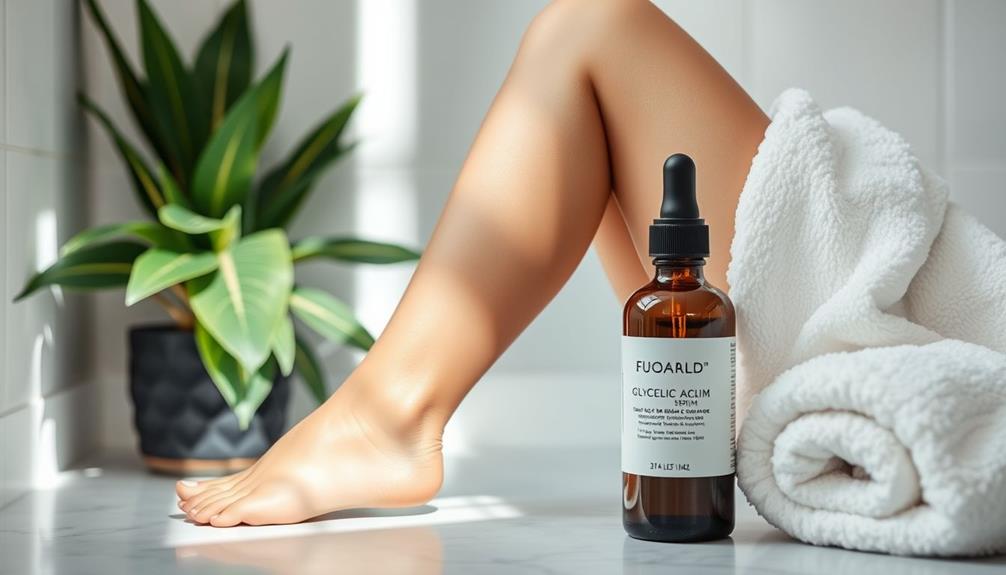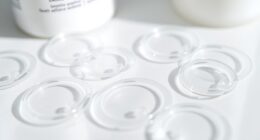Glycolic acid is your skin's new best friend! This alpha hydroxy acid, derived from sugar cane, exfoliates dead skin cells and boosts cell turnover for a brighter, smoother complexion. You'll notice reduced fine lines, improved firmness, and even skin tone as it fades dark spots and unclogs pores. It draws moisture into your skin, ensuring it stays hydrated and radiant. Start with lower concentrations and increase usage gradually to avoid irritation. Just remember to wear sunscreen daily, as glycolic acid can make your skin more sensitive to the sun. Discover all the incredible benefits it can offer for your skin!
Key Takeaways
- Glycolic acid is an alpha hydroxy acid that effectively exfoliates the skin, promoting a smoother texture and radiant appearance.
- It helps fade hyperpigmentation and dark spots, leading to a more even skin tone over time.
- By stimulating collagen production, glycolic acid reduces fine lines and enhances skin firmness and elasticity.
- The acid unclogs pores, making it beneficial for acne-prone skin and preventing future breakouts.
What Is Glycolic Acid?

Glycolic acid is a powerful alpha hydroxy acid (AHA) derived from sugar cane that effectively exfoliates and rejuvenates your skin. Its small molecular size allows it to penetrate deeply, making it an excellent choice for those seeking to improve their skincare routine.
Additionally, incorporating essential oils for skin health can enhance your overall skincare regimen. By promoting cell turnover, glycolic acid works to dissolve the bonds between dead skin cells, revealing smoother and more radiant skin underneath.
You'll find glycolic acid in various products, including cleansers, creams, toners, and chemical peels, making it a versatile ingredient for any skincare regimen. When used consistently, it helps in removing dead skin cells, which can lead to a brighter complexion.
The exfoliating properties of glycolic acid don't just enhance your skin's appearance; they also allow other active ingredients in your products to penetrate more effectively.
Whether you're looking to address uneven skin tone, rough texture, or signs of aging, incorporating glycolic acid into your skincare can greatly benefit your skin.
Benefits of Glycolic Acid

The benefits of glycolic acid are numerous, making it a game-changer in your skincare routine for achieving smoother, brighter, and more youthful-looking skin. This powerful alpha-hydroxy acid works wonders by exfoliating the skin, removing dead skin cells, and promoting a radiant complexion.
Here are some key benefits of glycolic acid:
| Benefit | Description | Result |
|---|---|---|
| Exfoliate the skin | Dissolves dead skin cells for a smooth surface | Brighter, refined texture |
| Fade dark spots | Targets hyperpigmentation for a uniform tone | Even skin color |
| Reduce fine lines | Stimulates collagen production for firmer skin | Youthful appearance |
| Acne treatment | Unclogs pores and prevents breakouts | Clearer complexion |
Additionally, glycolic acid helps hydrate skin by attracting moisture, enhancing its overall texture and elasticity. Regular use of this ingredient can greatly improve your skin tone, allowing you to enjoy a flawless look while reaping all the benefits of glycolic acid. So, whether you're dealing with fine lines, dark spots, or acne, incorporating glycolic acid can lead to remarkable results.
How Glycolic Acid Works

Glycolic acid works primarily through its exfoliation mechanism, breaking down the bonds between dead skin cells for easier removal.
This process not only smooths your skin texture but also stimulates collagen production, improving firmness and elasticity.
Incorporating regular skincare routines, similar to yoga for back pain management, can complement the effects of glycolic acid.
As a result, you'll notice a more radiant complexion and reduced signs of aging.
Exfoliation Mechanism Explained
As an alpha-hydroxy acid, glycolic acid effectively breaks down the bonds between dead skin cells, making it easier for you to achieve a smoother, more radiant complexion. By exfoliating the top layer of your skin, this powerful ingredient helps promote cell turnover, resulting in fresher, healthier skin. Its small molecular size allows glycolic acid to penetrate deeply, enhancing its efficacy in improving skin texture.
| Benefits | Effects |
|---|---|
| Exfoliates dead skin cells | Smoother skin |
| Promotes cell turnover | Radiant complexion |
| Reduces acne | Fewer clogged pores |
| Boosts collagen production | Firmer skin and improved elasticity |
Collagen Stimulation Effects
Collagen stimulation happens when glycolic acid activates fibroblasts in your skin, boosting the production of essential collagen and elastin fibers. This process is critical for improving skin firmness and elasticity, which can often diminish with age.
As you incorporate glycolic acid into your skincare routine, you'll likely notice a reduction in fine lines and wrinkles. Additionally, maintaining skin health is essential, as factors like regular trims can help prevent further damage and promote a more youthful appearance. Clinical studies have shown that regular use can greatly enhance collagen synthesis, leading to a more youthful look.
Glycolic acid's small molecular size allows it to penetrate deeply, promoting quicker cell turnover. This means dead skin cells are shed more efficiently, making way for fresh, collagen-rich skin. By breaking down the bonds between those dead skin cells, glycolic acid not only reduces collagen breakdown but also supports the overall health of your skin.
Moreover, increased collagen levels can improve skin texture and firmness while enhancing its overall radiance and luminosity. By including glycolic acid in your skincare regimen, you're effectively nurturing your skin's collagen production, ultimately resulting in a more vibrant, youthful look.
Usage Guidelines

When you're starting with glycolic acid, it's best to choose low-strength products around 5% and gradually increase the concentration as your skin becomes accustomed.
This mindful approach to skincare not only minimizes irritation but also aligns with the principles of holistic lifestyle approach that can enhance overall well-being.
Begin by applying it once or twice a week, and adjust the frequency based on how your skin reacts.
This approach helps you avoid irritation while reaping the benefits of glycolic acid.
Starting With Low Concentrations
To safely introduce glycolic acid into your skincare routine, start with products that contain around 5% concentration to gauge your skin's tolerance. This lower concentration is ideal, especially if you have sensitive skin.
Before applying glycolic acid, always perform a patch test on a small area to check for any adverse reactions.
Once you're comfortable, apply glycolic acid at night on dry skin after cleansing. This helps minimize irritation and enhances its effectiveness, as it may increase sun sensitivity.
Incorporate a good moisturizer after applying glycolic acid to maintain hydration and support your skin's barrier function.
Begin using it once or twice a week, and monitor how your skin responds. If your skin tolerates the product well, you can gradually increase to higher concentrations and adjust the frequency accordingly.
Always listen to your skin; if you notice discomfort or irritation, scale back your usage.
Remember, the goal is to enhance your skin's health while ensuring it remains hydrated and balanced.
Frequency of Application
It's essential to establish a consistent routine for applying glycolic acid, starting with once or twice a week to see how your skin reacts.
For at-home use, begin with lower concentrations, around 5%, and gradually increase the frequency of application based on your skin response. Pay attention to how your skin tolerates glycolic acid; if you notice any irritation, scale back the frequency or concentration.
Always apply glycolic acid at night after cleansing, as it can heighten sun sensitivity. Don't forget to follow up with sunscreen during the day.
Before diving into a regular routine, consider patch testing a small area of your skin to check for any adverse reactions.
While professional chemical peels can use higher concentrations and be performed every few weeks, at-home products shouldn't exceed a 10% concentration for regular use.
By starting slow and listening to your skin, you'll be able to safely enjoy the benefits of glycolic acid without overwhelming your skin.
Skin Type Suitability

Glycolic acid works wonders for normal, combination, and oily skin types by effectively exfoliating and unclogging pores. Its exfoliating properties make it especially beneficial for acne-prone skin, helping to improve texture and tone. However, if you have sensitive skin, it's important to approach glycolic acid with caution. Starting with lower concentrations can help gauge your skin's tolerance and minimize irritation.
Here's a quick reference table to help you determine glycolic acid's suitability for your skin type:
| Skin Type | Suitability | Recommendations |
|---|---|---|
| Normal Skin | Excellent | Use regular concentrations |
| Oily Skin | Excellent | Incorporate in your routine |
| Combination Skin | Good | Target oily areas with care |
| Sensitive Skin | Caution | Start with lower concentrations |
Always monitor your skin's response when adding glycolic acid to your skincare routine. For those with sensitive skin or specific conditions, consulting a dermatologist before use is advisable. This guarantees you achieve the best results without unwanted irritation.
Potential Side Effects

While glycolic acid offers impressive benefits, it's important to be aware of the potential side effects that can arise from its use.
Many users experience skin irritation, redness, or burning, especially if they've sensitive skin or use high concentrations. Overuse of glycolic acid can lead to peeling and dry skin, indicating your skin barrier may be compromised.
Increased sun sensitivity is another common side effect, making it essential to apply a broad-spectrum sunscreen daily to protect against UV damage. If you have darker skin tones, be cautious; misuse or excessive application of glycolic acid can cause hypopigmentation, which might be challenging to treat.
To minimize risks, always perform patch testing before fully incorporating glycolic acid into your routine. Stick to the recommended usage guidelines to avoid severe reactions, such as chemical burns, which, though rare, can occur.
Recommended Products

When selecting glycolic acid products for your skincare routine, aim for those with concentrations between 5-10% to effectively exfoliate without causing irritation.
These levels are ideal for at-home use and suit most skin types. You can find various options like glycolic acid cleansers, toners, and serums that easily fit into your daily regimen, enhancing your skin's texture and brightness.
If you're looking for more intensive results, consider glycolic acid peels available through dermatologists or licensed estheticians. These typically contain higher concentrations and deliver deeper exfoliation.
To mitigate dryness and improve tolerance, choose products enriched with hydrating ingredients, like hyaluronic acid, to keep your skin nourished.
Conclusion
Incorporating glycolic acid into your skincare routine is like finding the key to a hidden garden; it releases your skin's true potential.
With its ability to gently exfoliate and reveal a radiant complexion, you're not just treating your skin—you're nurturing it.
Remember to start slowly and listen to your skin's needs.
Embrace this transformative ingredient, and soon, you'll notice a vibrant glow that feels as revitalizing as a morning dew on blossoming petals.









